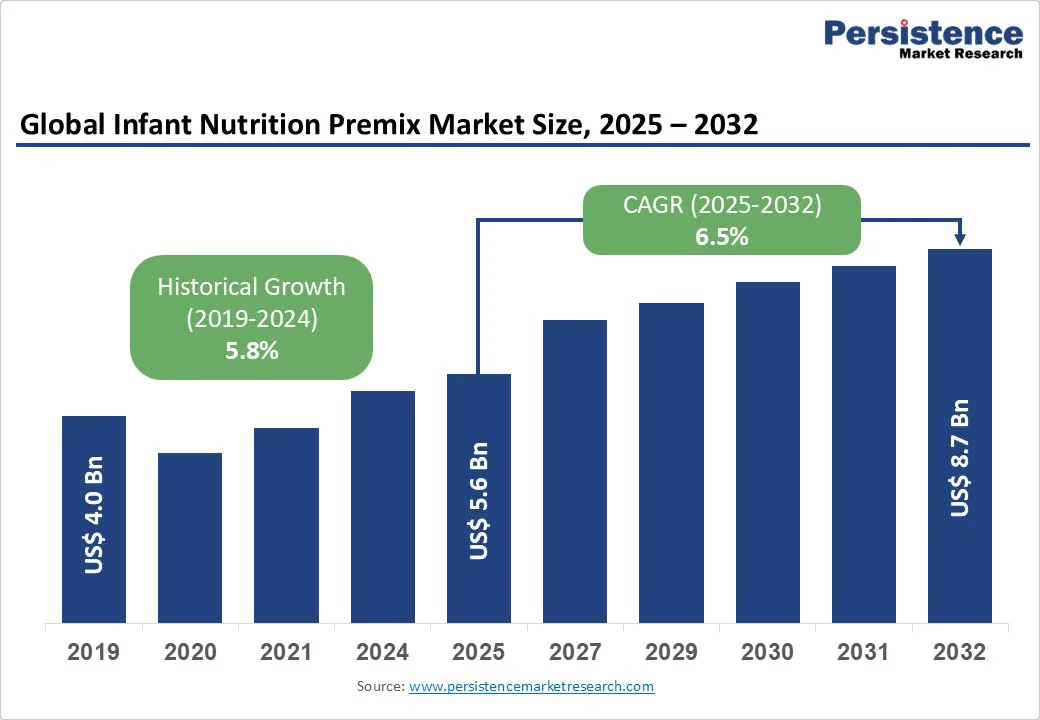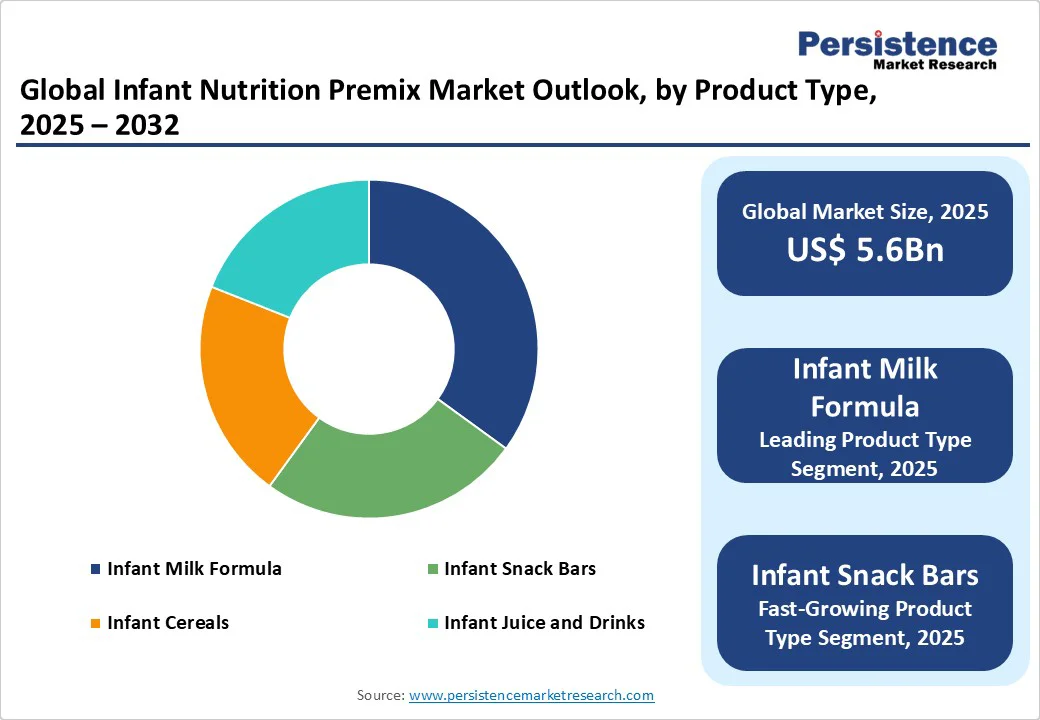ID: PMRREP21862| 193 Pages | 26 Sep 2025 | Format: PDF, Excel, PPT* | Food and Beverages

The global infant nutrition premix market size is likely to be valued at US$ 5.6 Bn in 2025 and is expected to reach US$ 8.7 Bn by 2032, growing at a CAGR of 6.5% during the forecast period from 2025 to 2032.
The infant nutrition premix market has witnessed robust growth, propelled by increasing awareness of infant health and nutrition, rising demand for fortified and specialized nutrition products, and advancements in premix formulation technologies.
| Global Market Attribute | Key Insights |
|---|---|
| Infant Nutrition Premix Market Size (2025E) | US$ 5.6 Bn |
| Market Value Forecast (2032F) | US$ 8.7 Bn |
| Projected Growth (CAGR 2025 to 2032) | 6.5% |
| Historical Market Growth (CAGR 2019 to 2024) | 5.8% |

The growing emphasis on infant health and nutrition is a significant driver shaping the infant formula and baby food market. Parents today are more informed and conscious about the importance of early childhood nutrition in supporting growth, immunity, and cognitive development.
This awareness has been fueled by rising access to healthcare information, pediatric recommendations, government-led nutrition campaigns, and digital platforms that educate caregivers on the critical role of balanced nutrition during the first 1,000 days of life.
Increasing incidences of malnutrition, food allergies, and deficiencies in developing nations have highlighted the need for safe, fortified, and scientifically formulated infant nutrition products. Urbanization, higher literacy rates among mothers, and dual-working parents are also contributing to demand, as families seek convenient yet nutritionally rich feeding options.
For instance, major brands are actively innovating to meet these needs by offering products enriched with probiotics, DHA, and essential vitamins to strengthen immunity and brain development. Companies such as Nestlé and Danone have launched awareness campaigns and partnered with healthcare professionals to educate parents about choosing the right nutritional products for infants, reinforcing the importance of science-backed nutrition in early life.
High production and regulatory costs represent a major restraint in the infant nutrition market, significantly impacting manufacturers’ profitability and pricing strategies. The production of infant formula and baby food requires adherence to strict safety, quality, and nutritional standards, as infants are among the most vulnerable consumers.
This involves sourcing premium-grade raw materials, ensuring contamination-free processing, and maintaining advanced manufacturing facilities equipped with stringent quality control systems. Such requirements raise operational costs considerably compared to other food products.
Companies must comply with rigorous regulations imposed by global and regional authorities such as the U.S. Food and Drug Administration (FDA), the European Food Safety Authority (EFSA), and Codex Alimentarius guidelines. These regulatory frameworks mandate extensive clinical testing, labeling transparency, and regular audits, all of which are time-consuming and expensive.
Furthermore, continuous changes in regulations across different markets add complexity and increase compliance costs for global brands. For instance, in 2022, Abbott Laboratories faced scrutiny and production disruptions after contamination concerns at its U.S. facility, leading to recalls and stricter compliance oversight. Such cases illustrate how high regulatory expectations and production standards can strain companies financially and operationally.
Advancements in personalized nutrition premixes present a significant opportunity for the infant nutrition market, aligning with the growing demand for tailored health solutions. Modern parents are increasingly aware that every child has unique nutritional requirements influenced by genetics, gut microbiota, lifestyle, and environmental factors.
This shift has created a strong push for customized infant formulas and baby foods enriched with specific nutrients to address individual health concerns such as allergies, digestive sensitivities, or developmental needs. Personalized premixes allow manufacturers to add targeted blends of vitamins, minerals, probiotics, omega-3 fatty acids, and other functional ingredients that support immunity, brain development, and overall growth.
Technological innovations in genomics, nutrigenomics, and microbiome research are further driving this trend, enabling companies to design nutrition solutions based on scientific insights into early childhood development. This not only enhances consumer trust but also fosters brand differentiation in a highly competitive market.
For instance, Nestlé launched its “Gerber Personalized Nutrition” initiative, leveraging digital tools and dietary assessments to recommend tailored nutrition products for infants and toddlers. Such innovations highlight how personalized premixes can revolutionize infant nutrition, offering parents solutions that are both science-driven and closely aligned with their child’s unique health profile.
Infant milk formula dominates, expected to account for approximately 35% share in 2025. Its dominance is attributed to its widespread use as a primary nutrition source for infants, particularly in cases where breastfeeding is not feasible.
Infant milk formula premixes, offered by companies such as Nestle and Royal FrieslandCampina, are fortified with essential nutrients such as DHA, ARA, and probiotics, ensuring comprehensive infant development. Their ease of use and alignment with global health standards drive adoption among parents and healthcare providers.
The infant snack bars segment is the fastest-growing, driven by increasing demand for convenient, nutrient-dense snacks for older infants and toddlers. These premixes cater to busy parents seeking portable, healthy options for on-the-go nutrition. The rise in organic and natural snack bar formulations, supported by companies such as Prinova Solutions, is accelerating adoption in developed markets such as North America and Europe.
The 0-6 months segment holds the largest market share, accounting for approximately 43% in 2025. This segment’s dominance is driven by the critical nutritional needs during the first six months of life, where infant milk formula and specialized premixes are essential for growth and immunity. Companies such as Vitablend focus on premixes tailored for this age group, incorporating nutrients such as iron and vitamin D to support early development.
The 12-24 months segment is the fastest-growing, fueled by increasing demand for premixes in toddler-specific products such as cereals and snack bars. As infants transition to solid foods, parents seek nutrient-rich premixes to support cognitive and physical development, driving growth in this segment, particularly in the Asia Pacific.
Supermarkets/Hypermarkets lead, holding a 32% share in 2025. Their dominance is driven by their extensive reach, trusted brand offerings, and ability to provide a wide range of infant nutrition products under one roof. Retail giants such as Walmart and Tesco stock premix-based products from key players such as Nestle, enhancing accessibility for consumers.
The online retail segment is the fastest-growing, propelled by the rise of e-commerce platforms and increasing consumer preference for convenient shopping. Platforms such as Amazon and specialized health stores offer a wide range of premix products, with subscription models and personalized recommendations driving adoption, particularly in urban areas of the Asia Pacific and North America.

North America is expected to hold a substantial 34% share in the global infant nutrition premix market in 2025, making it one of the most influential regions globally. This dominance is largely driven by the region’s advanced healthcare infrastructure, which ensures widespread access to pediatric guidance and nutrition-related information for parents.
The U.S., in particular, plays a central role, as it accounts for the majority of the regional demand. Parents in North America are highly aware of the critical importance of early childhood nutrition, leading to a strong preference for premium and science-backed infant formula and baby food products.
High purchasing power and lifestyle shifts, including an increase in working mothers, have accelerated the adoption of convenient, fortified, and ready-to-feed products. Moreover, ongoing innovations in personalized nutrition, organic baby food, and plant-based alternatives are finding significant traction among health-conscious North American consumers.
Strict regulatory standards set by agencies such as the FDA also ensure product safety and quality, further reinforcing consumer trust. For instance, Abbott Laboratories and Mead Johnson Nutrition (now part of Reckitt Benckiser) continue to dominate the U.S. market by introducing specialized formulas enriched with probiotics, DHA, and other functional ingredients tailored to infant development.
Europe is a significant player in the infant nutrition premix market, supported by strong regulatory frameworks and consumer demand for high-quality nutrition. Leading countries such as Germany, France, and the UK drive market growth, with companies such as Royal FrieslandCampina and DSM at the forefront of premix innovation. Germany’s market is propelled by its focus on organic and natural infant products, with strict EFSA regulations ensuring product safety.
France benefits from government-backed health campaigns promoting infant nutrition, while the UK sees rising demand for personalized premixes driven by digital health platforms. Europe’s emphasis on sustainability and clean-label products is encouraging manufacturers to develop eco-friendly premixes, reducing environmental impact. The region’s growing focus on combating childhood malnutrition and supporting cognitive development through fortified premixes ensures steady market growth.
Asia Pacific is emerging as the fastest-growing region in the infant nutrition market, fueled by rapid population growth, rising disposable incomes, and supportive government initiatives promoting infant health and nutrition. Countries such as China and India are at the forefront of this growth, given their large birth rates and expanding middle-class populations, which are increasingly able to afford premium and specialized infant products.
Parents in these markets are becoming more aware of the importance of balanced nutrition during the first few years of life, driving strong demand for fortified infant formulas, organic baby food, and products tailored to specific health needs such as immunity and cognitive development.
Government efforts are further accelerating this trend. For example, India’s Integrated Child Development Services (ICDS) program and China’s Healthy China 2030 initiative emphasize improved maternal and child health, creating a favorable environment for infant nutrition products.
Additionally, rapid urbanization, exposure to global health trends, and expanding modern retail and e-commerce platforms are making high-quality products more accessible to consumers. For instance, companies such as Nestlé, Danone, and Feihe are strengthening their presence in the Asia Pacific by investing in local production facilities and launching region-specific product lines, capturing the growing appetite for safe and premium infant nutrition solutions.

The global Infant Nutrition Premix market is highly competitive, featuring a blend of multinational leaders and strong regional players. In North America and Europe, companies such as Nestlé, DSM, and Glanbia Nutritionals maintain dominance through advanced R&D capabilities, well-established brand recognition, and close partnerships with healthcare providers.
These players leverage innovation in organic, hypoallergenic, and personalized premixes to meet the rising demand from health-conscious consumers. In the Asia Pacific, rapid population growth and increasing disposable incomes are fueling strong market expansion, attracting both global players such as Royal FrieslandCampina and regional companies such as Richen Nantong.
Competition is further intensified by localized strategies, government health initiatives, and the growing preference for clean-label products. Companies are also emphasizing sustainability through eco-friendly packaging, alongside digital marketing strategies to strengthen engagement with parents. While global leaders drive innovation and scale, regional players continue to carve out niches by addressing local dietary needs, creating a fragmented yet dynamic infant nutrition premix market.
The global infant nutrition premix market is projected to reach US$ 5.6 Bn in 2025.
Rising awareness of infant health and nutrition is a key driver.
The infant nutrition premix market is expected to witness a CAGR of 6.5% from 2025 to 2032.
Advancements in personalized nutrition premixes are a key opportunity.
Vitablend, Glanbia Nutritionals NA, BARENTZ, DSM, Nestle, Royal FrieslandCampina, Richen Nantong, and Prinova Solutions are key players.
| Report Attribute | Details |
|---|---|
| Historical Data/Actuals | 2019 - 2024 |
| Forecast Period | 2025 - 2032 |
| Market Analysis | Value: US$ Bn, Volume: As Applicable |
| Geographical Coverage |
|
| Segmental Coverage |
|
| Competitive Analysis |
|
| Report Highlights |
|
By Product Type
By Age Group
By Distribution Channel
By Region
Delivery Timelines
For more information on this report and its delivery timelines please get in touch with our sales team.
About Author